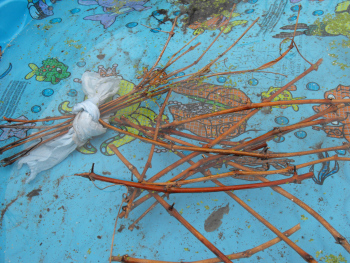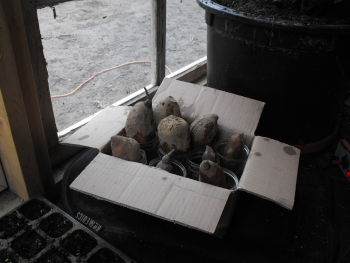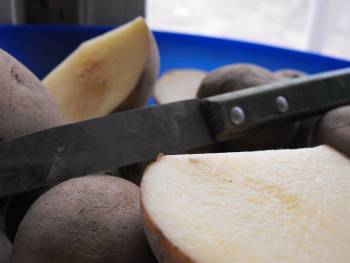
Propagation preparation
 The
last week in March is cloning week around here. First, I pulled
the grape cuttings out of the crisper drawer, where they'd been sitting
on top of a dwindling pile of last fall's carrots since December when I
pruned Mark's mom's vines. Scionwood is supposed to keep for
months in root cellar conditions, which I simulated by draping a damp
dish towel over the top of the drawer's contents, rewetting weekly to
keep the carrots and cuttings moist. I really didn't think the
grapes were still alive after three months off the vine, but when I
snipped off one end to test them, the cambium was fresh and green just
under the bark. Storage success!
The
last week in March is cloning week around here. First, I pulled
the grape cuttings out of the crisper drawer, where they'd been sitting
on top of a dwindling pile of last fall's carrots since December when I
pruned Mark's mom's vines. Scionwood is supposed to keep for
months in root cellar conditions, which I simulated by draping a damp
dish towel over the top of the drawer's contents, rewetting weekly to
keep the carrots and cuttings moist. I really didn't think the
grapes were still alive after three months off the vine, but when I
snipped off one end to test them, the cambium was fresh and green just
under the bark. Storage success!
 I tossed all of the cuttings
into the kiddie pool where we're experimenting with duckweed
for the chickens.
The grapes will take a few weeks to grow roots once I stick them in the
ground, so it's essential that the cuttings hydrate now in
preparation. After three days of soaking, I'll push them most of
the way into the ground in a well-drained and semi-shady spot, mulch
them well, and ignore them until the fall. I consider grapes to
be one of the easiest perennials to propagate --- read last year's
tutorial about starting
grapes from hardwood cuttings and give it a shot!
I tossed all of the cuttings
into the kiddie pool where we're experimenting with duckweed
for the chickens.
The grapes will take a few weeks to grow roots once I stick them in the
ground, so it's essential that the cuttings hydrate now in
preparation. After three days of soaking, I'll push them most of
the way into the ground in a well-drained and semi-shady spot, mulch
them well, and ignore them until the fall. I consider grapes to
be one of the easiest perennials to propagate --- read last year's
tutorial about starting
grapes from hardwood cuttings and give it a shot!
 Next, I pulled nine firm
tubers out of the cupboard to begin sweet
potato slip production.
I submerged the bottom third of the sweet potatoes in warm water and
placed them on a heating
pad (only necessary because our house is kept
cold.) In a couple of weeks, the bottoms of the tubers will grow
roots and the tops will sprout shoots. I'll clip the shoots and
place them in another cup of water, then set out dozens of free slips
in May. Sweet potato slips are extremely expensive at the feed
store, so it's thoroughly worth setting aside a bit of space in a sunny
window to start them yourself.
Next, I pulled nine firm
tubers out of the cupboard to begin sweet
potato slip production.
I submerged the bottom third of the sweet potatoes in warm water and
placed them on a heating
pad (only necessary because our house is kept
cold.) In a couple of weeks, the bottoms of the tubers will grow
roots and the tops will sprout shoots. I'll clip the shoots and
place them in another cup of water, then set out dozens of free slips
in May. Sweet potato slips are extremely expensive at the feed
store, so it's thoroughly worth setting aside a bit of space in a sunny
window to start them yourself.
 Finally,
Mark cut fifteen pounds of seed potatoes into sections, retaining two
or three eyes on each one. Last year, my potatoes were an abject
failure, mostly because I planted them in heavy clay, it rained all
summer, and a blight swept through the east coast. I want to
take a bit of extra care this year, letting the cut portions of the
seed potatoes callous over before they go into the ground by leaving
them exposed to air for a day or two after cutting. I also plan
to
give them well-drained raised beds in hope that our potatoes will do
better this year, regardless of the weather.
Finally,
Mark cut fifteen pounds of seed potatoes into sections, retaining two
or three eyes on each one. Last year, my potatoes were an abject
failure, mostly because I planted them in heavy clay, it rained all
summer, and a blight swept through the east coast. I want to
take a bit of extra care this year, letting the cut portions of the
seed potatoes callous over before they go into the ground by leaving
them exposed to air for a day or two after cutting. I also plan
to
give them well-drained raised beds in hope that our potatoes will do
better this year, regardless of the weather.
Want more in-depth information? Browse through our books.
Or explore more posts by date or by subject.
About us: Anna Hess and Mark Hamilton spent over a decade living self-sufficiently in the mountains of Virginia before moving north to start over from scratch in the foothills of Ohio. They've experimented with permaculture, no-till gardening, trailersteading, home-based microbusinesses and much more, writing about their adventures in both blogs and books.
Want to be notified when new comments are posted on this page? Click on the RSS button after you add a comment to subscribe to the comment feed, or simply check the box beside "email replies to me" while writing your comment.
- Remove comment
- Remove comment
- Remove comment
 ) With grapes and sweet potatoes, though, there's no need for rooting hormones of any type --- both plants root quickly and easily with no help.
) With grapes and sweet potatoes, though, there's no need for rooting hormones of any type --- both plants root quickly and easily with no help.
- Remove comment
